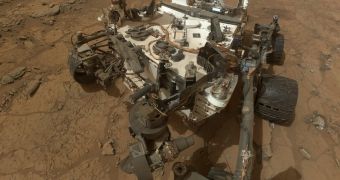Scientists with the NASA Jet Propulsion Laboratory (JPL), in Pasadena, California, say that the Mars Science Laboratory rover Curiosity experienced a warm reset even on Thursday, November 7. The unexpected software reboot did not trigger any unwanted side-effects in the robot's operations.
The error occurred as Curiosity was relaying a batch of data to the NASA Mars Reconnaissance Orbiter. The MRO usually receives data from the MSL rover, and then relays it back to Earth. This method of communication is efficient because the orbiter takes its power straight from the Sun.
Curiosity is currently undergoing a week of flight software updates and checkout activities, which have been planned at JPL since before the mission was lost. The nuclear-powered robot was sending engineering and science data to the MRO as it was receiving a new flight software.
About four and a half hours after the software was temporarily downloaded into its memory, its computers experienced the warm reboot event, which occurs whenever they detect an anomaly in the software being run on the explorer. This safety measure prevents any lasting damage.
NASA experts say that this is the first time a fault-related warm reset occurred in Curiosity's computers, since the rover touched down on the surface of the Red Planet, on August 6, 2012. As a result, they are now investigating the code that apparently led to the fault.
“Telemetry later downlinked from the rover indicates the warm reset was performed as would be expected in response to an unanticipated event,” says the MSL Project Manager at JPL, Jim Erickson. He adds that the rover is currently performing its mission as usual.
Curiosity launched towards Mars on November 26, 2011, aboard an Atlas V heavy-lift rocket. Takeoff occurred from Launch Pad 41 at the USAF Cape Canaveral Air Force Station, in Florida.
Weighing nearly a ton, and boasting the dimensions of a Mini Cooper, the rover is distinguished from any other robot to roam the surface of the Red Planet through the fact that it is powered by a radioisotope thermoelectric generator (RTG).

 14 DAY TRIAL //
14 DAY TRIAL //